Liquid Chromatography Tandem Mass Spectrometry Method for Novel Psychoactive Substances: Kratom and Synthetic Cathinones in Urine
Special Issues
A novel “dilute-and-shoot” LC–MS/MS method is described for the analysis of “bath salts” sold as “legal” highs, including mitragynine and nine synthetic cathinones, in urine.
A novel "dilute-and-shoot" method is described for the analysis of "bath salts" sold as "legal" highs, including mitragynine and nine synthetic cathinones. The cycle time for this method is 2.5 min. No sample clean-up or extraction was performed. This assay monitors two tandem mass spectrometry (MS/MS) transitions for each of the following 10 analytes: alpha-PVP, butylone, ethylone, MDPV, mephedrone, methcathinone, methedrone, methylone, naphyrone, and mitragynine; and two internal standards: methylone D3 and alpha-PVP D8. This straightforward "dilute-and-shoot" liquid chromatography (LC)–MS/MS method produces acceptable limit of detection (LOD) and limit of quantitation (LOQ) limits without costly extraction and time-consuming concentration protocols.
Cathinone is a monoamine alkaloid found in the Khat plant (Catha edulis) (1). Khat is a shrub grown in eastern Africa and the southern Arabian Peninsula, which can have mild stimulant effects when the leaves are chewed (2). Cathinone is also a beta ketone analog of amphetamine and as such is reported to cause sympathomimetic effects as well as psychoactive effects common with amphetamine and amphetamine derivatives such as MDMA ("Ecstasy") and MDA ("Eve") (3). Chewing of the Khat plant has been linked to increased risk of heart-related diseases and duodenal ulcers (4). Synthetic variants of cathinone, commonly referred to as "bath salts" or as "novel psychoactive substances" (NPS) by public health personnel, are stronger and more dangerous than their natural counterpart (5). The first synthetic derivatives of cathinone were reported during the 1920s (6-8). These initial derivatives were designed for medical purposes; however, most were withdrawn as a result of abuse and obvious dependency among users. Interestingly, bupropion (Wellbutrin) is a "synthetic cathinone" and is widely used as an antidepressant and anti-anxiety medicine (2).
More recently, synthetic cathinones (NPS) have expanded as popular drugs of abuse. Their ready availability in the local drug market and so-called head shops make them easy "legal" highs. These active agents are sold under various names such as pesticides and insect repellants. They are often labeled as "not for human consumption," to avoid regulatory control. However, the use of bath salts has significantly increased in recent years with poison control centers in the United States reporting 304 calls related to bath salts in 2010 and 1782 calls in the first four months of 2011 (9,10). It is believed that the increase in their use is a result of their availability, lack of proper methods for drug testing, and media coverage.
Mitragynine is a naturally occurring substance found in the leaves of the kratom (Mitragyna speciosa) plant, a member of the coffee family found in Southeast Asia, Indochina, and Malaysia (11). This "legal" high is readily available and is often used to mitigate pain, aid in opiate withdrawal, and for recreational purposes (12). This natural drug is regulated in a number of countries including Malaysia but not currently scheduled in the United States (13).
Urine drug testing is a common means of monitoring for the use of these drugs. While forensic laboratories often have access to blood, urine, and other tissues to test in post-mortem subjects, pain management laboratories tend to focus on urine or oral fluids because of the ease of sampling and minimal stability requirements. As well as ease of sample collection, the sample preparation required is comparatively easier for urine than other patient specimens, for example, blood. Often such preparation consists of sample matrix removal using solid-phase extraction (SPE); however, reports of “dilute-and-shoot” testing confirm that direct analysis without sample preparation is possible for some analytes (14). In this study, a unique “dilute-and-shoot” liquid chromatography–tandem mass spectrometry (LC–MS/MS) method was developed and validated for the analysis of nine synthetic cathinones and mitragynine (Kratom) in patient urine samples. This method is ideal for a high-throughput production environment because it has a modest 2.5-min cycle time and requires low sample preparation time and cost while still preserving sensitivity and specificity of the quantitative analytical result. Above all, this method achieved complete chromatographic resolution of the isobars, ethylone and butylone, both of which are analyzed in this method, by lowering column temperature to 20 °C and cutting flow rate to 0.4 mL/min to maintain system pressure.
Materials and Methods of Analysis
Reagents
All reference standard compounds, including internal standards, were purchased from Cerilliant. Solvents, including methanol, acetonitrile, and formic acid, were purchased from VWR. Normal drug-free urine was obtained from UTAK.
Preparation of Calibration Standards
Aliquots of normal drug-free urine were fortified with the reference standards at concentrations of 25 ng/mL, 250 ng/mL, and 1000 ng/mL as calibrators. All samples, calibrators, and controls were diluted 5× with the internal standard solution (0.5 µg/mL methylone D3 and alpha-PVP D8) by adding 400 µL of internal standard to 100 µL of sample.
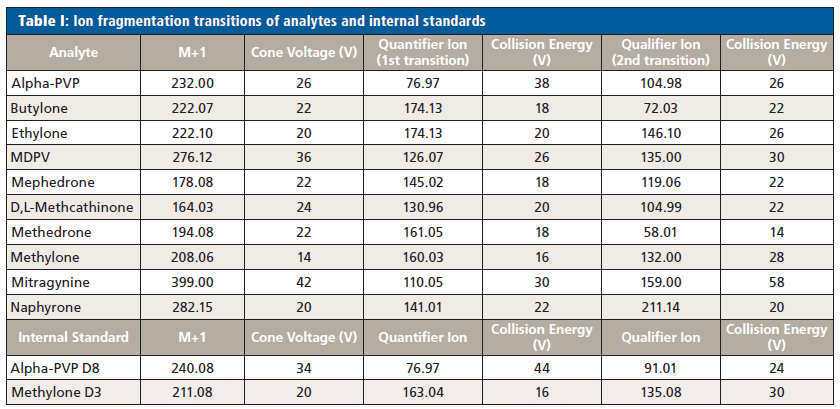
Instrumentation
All analyses were performed via LC–MS/MS on Acquity TQD UPLC/MS/MS system (Waters). A 2.1 × 50 mm, 1.7-µm Acquity UPLC BEH C18 analytical column (Waters) was used for chromatographic separations. The run time for this method was 2.0 min with a total cycle time of 2.5 min. No sample extraction or clean-up was required before LC–MS/MS analysis. Two transitions were monitored for each of 10 analytes (alpha-PVP, butylone, ethylone, MDPV, mephedrone, d,l-methcathinone, methedrone, methylone, mitragynine, and naphyrone), plus two internal standards (methylone D3 and alpha-PVP D8), as shown in Table I. Elution solvents used in the gradient were 0.1% formic acid in 10% methanol (mobile phase A) and 0.1% formic acid in 50:50 methanol– acetonitrile (mobile phase B), with a flow rate of 0.4 mL/min (Table II).
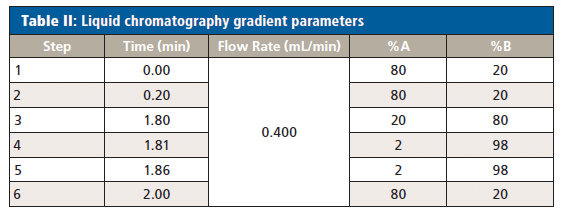
Method Validation
The method was validated by examining various parameters such as limits, linearity, precision and accuracy (P&A: Ten replicates of each of three concentrations each day for three days with coefficient of variance [%CV] of each set of P&A point replicates each day and across all P&A days falling within +/- 15%), interferences, and matrix effects. Drugs of abuse (benzoylecgonine, THC-A, amphetamine, methamphetamine, MDMA, MDEA, MDA, and phentermine) and therapeutic drugs (oxazepam, morphine, imipramine, buprenorphine, fentanyl, meprobamate, methadone, tramadol, gabapentin, pregabalin, and tapentadol) were tested as possible sources of interferences. Patient samples were evaluated by comparing the quantitative results of a previously used method with those of the new method as described herein. Since mitragynine and alpha-PVP were not evaluated in the previous method, a comparison was not possible. The previous method was developed and validated as described here but lacked critical analytes, for example, mitragynine and alpha-PVP. This method has not been reported in the literature. Detailed discussion of these validation parameters can be found in a paper by Enders and McIntire (14).
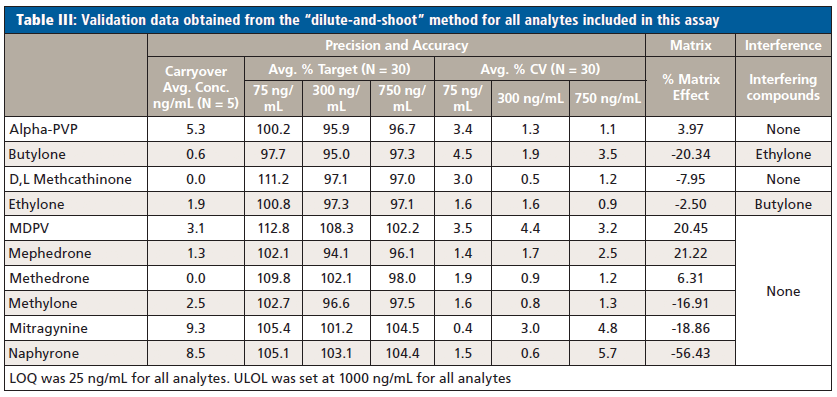
The tolerance for all analytes at each concentration level was ± 25%. All daily calibration curves had correlation coefficient values (r2) greater than or equal to 0.99. The matrix blanks following the highest calibrator points did not show any signs of carryover, that is, no response greater than 50% of the limit of quantitation (LOQ).
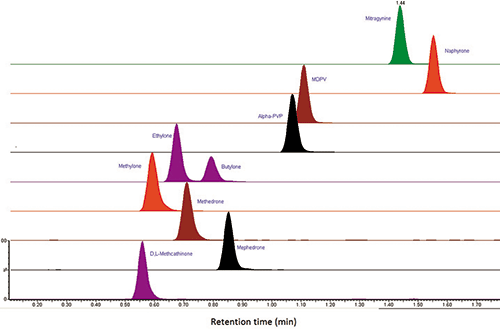
Figure 1: Overlaid chromatogram of 10 analytes determined in this assay. The chromatogram was obtained after injecting a sample at the limit of quantification (LOQ) of 25 ng/mL. Internal standards (IS) are not shown.
Two mass transitions were selected for each of the analytes following infusion studies of pure standards dissolved in matrix. The first transition served as the quantifier ion transition and the second transition served as a qualifier ion transition (Table I). The ratio of the areas of the quantifier ion transitions for the analyte of interest and the internal standard (IS) were used to obtain the relative response by plotting the area ratio of the analyte-to-IS versus analyte concentration. The area of the second ion transition of the analyte was used to generate a specific relative ratio to the area of the quantifier peak. This generates a compound specific “ion ratio” for each analyte that together with retention time helps to confirm that the peak results from the compound of interest.

Figure 2: Chromatogram showing the separation of the isomers ethylone and butylone.
Results
This method generated calibration data with consistent peak areas and ion ratios for all analytes and internal standards. Daily three-point calibration curves were completed with correlation coefficient values (r2) of at least 0.99 for all analytes. Consistent accuracies of 100 ± 25% were obtained for all calibration points, negative and positive controls, as well as points generated daily for both calibration and controls. The limit of quantification (LOQ) was determined to be 25 ng/mL, which was sufficient to achieve consistent precision and accuracies as well as acceptable ion ratios, while the upper limits of linearity and of carryover (ULOL, ULOC) were 1000 ng/mL. The chromatogram of all analytes shown in Figure 1 provides clear evidence that there is good chromatographic separation and resolution of all analytes assessed in this assay even at the LOQ. Furthermore, Figure 2 shows the separation achieved for the ethylone and butylone isobars, while Table III shows a summary of the validation results.

Table IV: Positive NPS data from a 14-month period of testing
Conclusions
This work documents the successful development and validation of an improved LC–MS/MS method for routine, high-throughput analysis of alpha-PVP, butylone, ethylone, MDPV, mephedrone, d,l-methcathinone, methedrone, methylone, mitragynine, and naphyrone, using methylone D3 and alpha-PVP D8 internal standards. During the initial stages of method development, the column temperature was held at 50 °C with a flow rate of 0.8 mL/min, which required a much longer 4.0 min cycle time for complete resolution of all analytes of interest. This was especially true for the isobars butylone and ethylone, which did not exhibit robust separation even with the longer elution time. To ensure complete resolution (< 10% peak height overlap) of these two isobars while still achieving the desired 2.5 min cycle time, the column temperature was lowered to 20 °C and the flow rate was decreased to 0.4 mL/min. Traditional chromatography paradigms indicate that higher temperatures lead to better resolution (15). However, the unique combination of column, solvents, analytes, and flow rates used here responded to lowering the temperature for improved resolution. Lowering the column temperature coupled with decreasing the gradient flow rates proved vital to ensure that appropriate system pressures were maintained while facilitating the appropriate degree of separation of the isomers, ethylone and butylone.
The synthetic cathinone compounds of interest were successfully analyzed in urine samples by this “dilute-and-shoot” LC–MS/MS method. This particular method is robust and useful because it reduces analysis time and does not incur additional costs for up-front sample preparation while still providing accurate results. As there were no interferences observed from the major drugs of abuse and therapeutic drugs, this method is an excellent tool for the clinical, medicinal, and toxicology communities, especially in high sample volume settings.
Results achieved with this method are summarized in Table IV where positive data from over a year of testing are summarized. Mitragynine was the most prevalent component in the tested urine samples, while alpha-PVP and methcathinone were close seconds. Although tests for these analytes are positive for just a small fraction of all pain medication monitoring samples, these results are important to both physicians and patients in their ongoing treatments for chronic pain, substance abuse, and mental illness. For example, patient ages associated with at least one positive bath salt result ranged from 19 to 72 years old, with equal positivity rates across all age groups. Lastly, the overwhelming positivity of mitragynine in this group more than likely reflects the legality of this natural product in many states in the USA, while attempts to schedule this agent at the federal level have been delayed by consumer activist protests (13).
Any method that tests for illicit synthetic substances must be updated frequently to keep up with the changes on “the street” that result in novel pharmaceutical substances being consumed with known and unknown effects. However, this method offers advantages in terms of cost and time and has been shown to be capable of detecting many patient positives when implemented for large numbers of samples.
Acknowledgments
The authors would like to thank the National Science Foundation (NSF-GOALI Award 1611072) for financial support of this work, together with Wake Forest University and Ameritox.
References
(1) N.T. Wabe, Chemistry, Addict & Health 3(3–4), 137–149 (2011).
(2) J.M. Prosser and L.S. Nelson, J. Med. Toxicol. 8(1), 33–42 (2012).
(3) M. Coppola and R. Mondola, Toxicology Letters 211(2), 144–149 (2012).
(4) A. Al-Motarreb, M. Al-Habori, and K.J. Broadley, J. Ethnopharmacol. 132(3), 540–548 (2010).
(5) M.H. Baumann, Addiction 109(10), 1577–1579 (2014).
(6) J.F. Hyde, E. Browning, and R. Adams, J. Am. Chem. Soc. 50(8), 2287–2292 (1928).
(7) C.D. Rosenbaum, S.P. Carreiro, and K.M. Babu, J. Med. Toxicol. 8(1), 15–32 (2012).
(8) C.L. German, A.E. Fleckenstein, and G.R. Hanson, Life Sci. 97(1), 2–8 (2014).
(9) https://www.medicinenet.com/bath_salts_abuse_and_addiction/article.htm.
(10) J.J. Palamar, Am. J. Addict. 24(6), 488–491 (2015).
(11) W.C. Prozialeck, J.K. Jivan, and S.V. Andurkar, J. Am. Osteopathic. Assoc. 112(12), 792–799 (2012).
(12) M.A. Rech, E. Donahey, J.M. Cappiello Dziedzic, L. Oh, and E. Greenhalgh, Pharmacotherapy 35(2), 189–97 (2015).
(13) http://kratomonline.org/is-kratom-legal/. Kratom Online.
(14) J.R. Enders and G.L. McIntire, J. of Anal Tox., 39(8), 662–667 (2015).
(15) S. Heinisch and J.L. Rocca, J. Chromatogr. A 1216(4), 642–658 (2009).
Debashish Roy and Allyson L. Mellinger are with the Chemistry Department at Wake Forest University in Winston-Salem, North Carolina and Ameritox, LLC, in Greensboro, North Carolina. Oneka T. Cummings, Erin C. Strickland, and Gregory L. McIntire are with Ameritox. Christa L. Colyer is with the Chemistry Department at Wake Forest University. Direct correspondence to: Greg.McIntire@ameritox.com
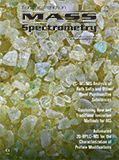
LIBS Illuminates the Hidden Health Risks of Indoor Welding and Soldering
April 23rd 2025A new dual-spectroscopy approach reveals real-time pollution threats in indoor workspaces. Chinese researchers have pioneered the use of laser-induced breakdown spectroscopy (LIBS) and aerosol mass spectrometry to uncover and monitor harmful heavy metal and dust emissions from soldering and welding in real-time. These complementary tools offer a fast, accurate means to evaluate air quality threats in industrial and indoor environments—where people spend most of their time.
NIR Spectroscopy Explored as Sustainable Approach to Detecting Bovine Mastitis
April 23rd 2025A new study published in Applied Food Research demonstrates that near-infrared spectroscopy (NIRS) can effectively detect subclinical bovine mastitis in milk, offering a fast, non-invasive method to guide targeted antibiotic treatment and support sustainable dairy practices.
Smarter Sensors, Cleaner Earth Using AI and IoT for Pollution Monitoring
April 22nd 2025A global research team has detailed how smart sensors, artificial intelligence (AI), machine learning, and Internet of Things (IoT) technologies are transforming the detection and management of environmental pollutants. Their comprehensive review highlights how spectroscopy and sensor networks are now key tools in real-time pollution tracking.